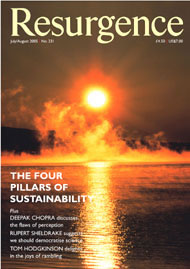SUSTAINABLE LIVING stands on four pillars: science, spirituality, technology and art. In this issue of Resurgence we focus on these four essential pillars. But what kinds of science, spirituality, technology, and art? These are contentious questions.
There is mechanistic science which does not recognise anything other than what can be measured, quantified and analysed. Such science looks at the Earth and the natural world and sees it as a machine. But there is another kind of science: the science of wholeness and the implicate order; the science of Gaia, the living Earth; the science that accepts the principles of uncertainty, mystery and surprise. Which science do we choose?
Spirituality also has two aspects. There is a 'flaky' spirituality which limits itself to personal growth. But there is also a spirituality which is engaged with the world: the spirituality of everyday life; the spirituality of compassion, imagination, beauty and generosity of the spirit. Which spirituality should we choose?
Then there are two kinds of technology: one is developed for war and for commercial profit. Nuclear, nano- and biotechnology fall into this category because they disregard natural rhythms and human aspirations. Strong, powerful and privileged governments and corporations use and misuse these technologies for their own narrow ends. But there is another kind of technology that is appropriate, benign and renewable and makes a small footprint on the Earth. Such technologies work in harmony with nature, rather than attempting to dominate or conquer her. Which technology should we choose?
Art also takes two forms. The first is celebrity and commercial art, which is disengaged from the concerns of the world. This isolationistic and egotistic art has little to do with the ecological, spiritual or social challenges of our time. As long as the artist is made into a celebrity, as long as art creates controversy, then the aims of art are considered to be met.
But there is another kind of art: art with integrity; art that inspires, uplifts and serves the greater purpose of life. Which art should we choose?
These are clear choices: between sceptical science and holistic science, between selfish spirituality and inclusive spirituality, between triumphant technology and tender technology, between egotistic art and art with integrity.
We have already made some fatal choices: we have ruined Hiroshima and Chernobyl, we have devastated landscapes and created dust-bowls, we are destroying rain forests and causing the icecaps to melt, we are perpetuating unjust and fragmented societies and fuelling religious conflicts around the world. It is time to change our direction. It is time to choose. The choice is ours and the choice is crucial.








